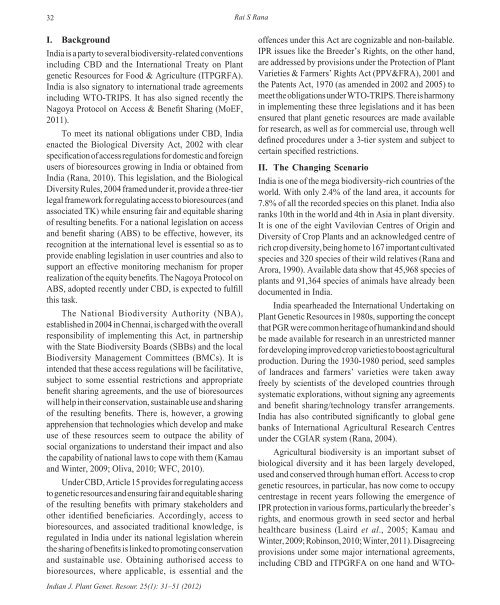indian society of plant genetic resources - Bioversity International
indian society of plant genetic resources - Bioversity International
indian society of plant genetic resources - Bioversity International
You also want an ePaper? Increase the reach of your titles
YUMPU automatically turns print PDFs into web optimized ePapers that Google loves.
32<br />
I. Background<br />
India is a party to several biodiversity-related conventions<br />
including CBD and the <strong>International</strong> Treaty on Plant<br />
<strong>genetic</strong> Resources for Food & Agriculture (ITPGRFA).<br />
India is also signatory to international trade agreements<br />
including WTO-TRIPS. It has also signed recently the<br />
Nagoya Protocol on Access & Benefi t Sharing (MoEF,<br />
2011).<br />
To meet its national obligations under CBD, India<br />
enacted the Biological Diversity Act, 2002 with clear<br />
specifi cation <strong>of</strong> access regulations for domestic and foreign<br />
users <strong>of</strong> bio<strong>resources</strong> growing in India or obtained from<br />
India (Rana, 2010). This legislation, and the Biological<br />
Diversity Rules, 2004 framed under it, provide a three-tier<br />
legal framework for regulating access to bio<strong>resources</strong> (and<br />
associated TK) while ensuring fair and equitable sharing<br />
<strong>of</strong> resulting benefi ts. For a national legislation on access<br />
and benefi t sharing (ABS) to be effective, however, its<br />
recognition at the international level is essential so as to<br />
provide enabling legislation in user countries and also to<br />
support an effective monitoring mechanism for proper<br />
realization <strong>of</strong> the equity benefi ts. The Nagoya Protocol on<br />
ABS, adopted recently under CBD, is expected to fulfi ll<br />
this task.<br />
The National Biodiversity Authority (NBA),<br />
established in 2004 in Chennai, is charged with the overall<br />
responsibility <strong>of</strong> implementing this Act, in partnership<br />
with the State Biodiversity Boards (SBBs) and the local<br />
Biodiversity Management Committees (BMCs). It is<br />
intended that these access regulations will be facilitative,<br />
subject to some essential restrictions and appropriate<br />
benefi t sharing agreements, and the use <strong>of</strong> bio<strong>resources</strong><br />
will help in their conservation, sustainable use and sharing<br />
<strong>of</strong> the resulting benefi ts. There is, however, a growing<br />
apprehension that technologies which develop and make<br />
use <strong>of</strong> these <strong>resources</strong> seem to outpace the ability <strong>of</strong><br />
social organizations to understand their impact and also<br />
the capability <strong>of</strong> national laws to cope with them (Kamau<br />
and Winter, 2009; Oliva, 2010; WFC, 2010).<br />
Under CBD, Article 15 provides for regulating access<br />
to <strong>genetic</strong> <strong>resources</strong> and ensuring fair and equitable sharing<br />
<strong>of</strong> the resulting benefi ts with primary stakeholders and<br />
other identifi ed benefi ciaries. Accordingly, access to<br />
bio<strong>resources</strong>, and associated traditional knowledge, is<br />
regulated in India under its national legislation wherein<br />
the sharing <strong>of</strong> benefi ts is linked to promoting conservation<br />
and sustainable use. Obtaining authorised access to<br />
bio<strong>resources</strong>, where applicable, is essential and the<br />
Indian J. Plant Genet. Resour. 25(1): 31–51 (2012)<br />
Rai S Rana<br />
<strong>of</strong>fences under this Act are cognizable and non-bailable.<br />
IPR issues like the Breeder’s Rights, on the other hand,<br />
are addressed by provisions under the Protection <strong>of</strong> Plant<br />
Varieties & Farmers’ Rights Act (PPV&FRA), 2001 and<br />
the Patents Act, 1970 (as amended in 2002 and 2005) to<br />
meet the obligations under WTO-TRIPS. There is harmony<br />
in implementing these three legislations and it has been<br />
ensured that <strong>plant</strong> <strong>genetic</strong> <strong>resources</strong> are made available<br />
for research, as well as for commercial use, through well<br />
defi ned procedures under a 3-tier system and subject to<br />
certain specifi ed restrictions.<br />
II. The Changing Scenario<br />
India is one <strong>of</strong> the mega biodiversity-rich countries <strong>of</strong> the<br />
world. With only 2.4% <strong>of</strong> the land area, it accounts for<br />
7.8% <strong>of</strong> all the recorded species on this planet. India also<br />
ranks 10th in the world and 4th in Asia in <strong>plant</strong> diversity.<br />
It is one <strong>of</strong> the eight Vavilovian Centres <strong>of</strong> Origin and<br />
Diversity <strong>of</strong> Crop Plants and an acknowledged centre <strong>of</strong><br />
rich crop diversity, being home to 167 important cultivated<br />
species and 320 species <strong>of</strong> their wild relatives (Rana and<br />
Arora, 1990). Available data show that 45,968 species <strong>of</strong><br />
<strong>plant</strong>s and 91,364 species <strong>of</strong> animals have already been<br />
documented in India.<br />
India spearheaded the <strong>International</strong> Undertaking on<br />
Plant Genetic Resources in 1980s, supporting the concept<br />
that PGR were common heritage <strong>of</strong> humankind and should<br />
be made available for research in an unrestricted manner<br />
for developing improved crop varieties to boost agricultural<br />
production. During the 1930-1980 period, seed samples<br />
<strong>of</strong> landraces and farmers’ varieties were taken away<br />
freely by scientists <strong>of</strong> the developed countries through<br />
systematic explorations, without signing any agreements<br />
and benefi t sharing/technology transfer arrangements.<br />
India has also contributed signifi cantly to global gene<br />
banks <strong>of</strong> <strong>International</strong> Agricultural Research Centres<br />
under the CGIAR system (Rana, 2004).<br />
Agricultural biodiversity is an important subset <strong>of</strong><br />
biological diversity and it has been largely developed,<br />
used and conserved through human effort. Access to crop<br />
<strong>genetic</strong> <strong>resources</strong>, in particular, has now come to occupy<br />
centrestage in recent years following the emergence <strong>of</strong><br />
IPR protection in various forms, particularly the breeder’s<br />
rights, and enormous growth in seed sector and herbal<br />
healthcare business (Laird et al., 2005; Kamau and<br />
Winter, 2009; Robinson, 2010; Winter, 2011). Disagreeing<br />
provisions under some major international agreements,<br />
including CBD and ITPGRFA on one hand and WTO-

















